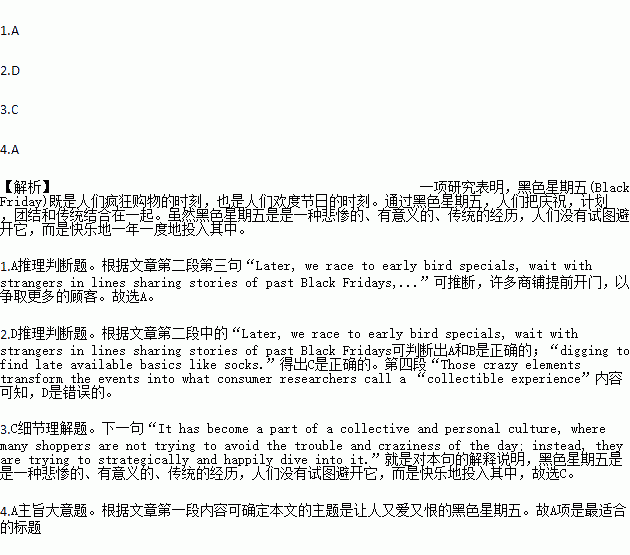题目内容
An investigative study of Black Friday, led by West Chester University Professor Gina Castle Bell, observed themes of consumerism but also observed the themes of a happy holiday. The researchers found through Black Friday people celebrate, plan, bond, and build traditions together.
For me my Black Friday always begins and ends on a living room floor littered with newspaper ads. There, late on Thanksgiving night, my family collectively holds a strategy session. Later, we race to early bird specials, wait with strangers in lines sharing stories of past Black Fridays, take a long relaxing lunch full of family banter(戏谑), get Christmas decorations, stop into a Cheesecake Factory bar to see the dramatic end of a football game, get a caffeine-high from Starbucks Christmas drinks, and end the shopping at a torn apart Old Navy(美国服装品牌), digging to find late available basics like socks. Finally, exhausted but contented, we collapse back on that living room floor, still littered with ads, where we drink hot cocoa, watch a Christmas movie, and plan to hang the new decorations.
This is not to say that Black Friday is always lovely. Instead, it’s often miserable. But the misery is sort of what makes Black Friday such a great tradition. Many Black Friday shoppers know that the deals on Black Friday are not especially great and are available online. But they did not show up for the deals, they showed for the “misery”.
For them the crowds, the rush, and the difficulty all enhance(提升) Black Friday—similar to the way crowds enhance movie opening nights, the rush enhances music festivals, and difficulty enhances the experience of camping for other types of people. Those crazy elements transform the events into what consumer researchers call a “collectible experience”. Collectible experiences are not always pleasant but they are memorable and meaningful to those games for them.
There seems to be a mad rush in the media to analyze Black Friday. Yet, every analysis misses the point that Black Friday, which though on the surface seems like just evil consumerism, is actually, for some, quite a meaningful, ritualistic(例行的) experience.
Maybe this happy holiday is not for you. Maybe you think it is silly or even disgusting that Americans choose to bond through, over all other options, shopping. But what you cannot deny is that Black Friday has become something bigger than deals. It has become a part of a collective and personal culture, where many shoppers are not trying to avoid the trouble and craziness of the day; instead, they are trying to strategically and happily dive into it. And, right now, on living room floors all across America, families are planning how to get the most out of their yearly ritual.
1.It can be inferred from Paragraph 2 that .
A. many shops open ahead of schedule to compete with others for more customers
B. many shops offer free drinks to customers when they watch football games
C. the author purchases cheap socks and the room floor collapses under their weight
D. the author stops shopping at an old and shabby store late on Thanksgiving night
2.Which of the following does NOT belong to a “collectible experience”?
A. Waiting with strangers in lines. B. Racing to early bird specials.
C. Digging to find commodities. D. Transforming crazy elements.
3.By saying “Black Friday has become something bigger than deals”, the author means Black Friday .
A. would be enjoyed more if it was less commercial
B. is a great chance to feel comfortable and relaxed
C. is a miserable, meaningful and traditional experience
D. undergoes a comprehensive evaluation from the media
4.What could be the best title of the passage?
A. A Loving Defense of Black Friday
B. An Introduction to Black Friday
C. Widespread Criticism of Black Friday
D. Fantastic Experience of Black Friday

